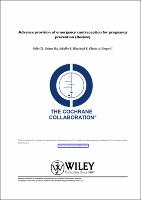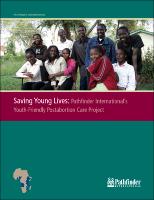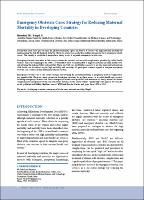Mostrar el registro sencillo del ítem
Advance provision of emergency contraception for pregnancy prevention (Review)
| dc.contributor.author | Polis, Chelsea | |
| dc.contributor.author | Grimes, David | |
| dc.contributor.author | Schaffer, Kate | |
| dc.contributor.author | Blanchard, Kelly | |
| dc.contributor.author | Glasier, Anna | |
| dc.contributor.author | Harper, Cynthia | |
| dc.date.accessioned | 2011-09-27T12:40:40Z | |
| dc.date.available | 2011-09-27T12:40:40Z | |
| dc.date.issued | 2010 | |
| dc.identifier.citation | London;The Cochrane Collaboration;2010;36 p. | es_ES |
| dc.identifier.uri | http://clacaidigital.info/handle/123456789/194 | |
| dc.description.abstract | Background Emergency contraception can prevent pregnancy when taken after unprotected intercourse.Obtaining emergency contraception within the recommended time frame is difficult for many women. Advance provision could circumvent some obstacles to timely use. Objectives To summarize randomized controlled trials evaluating advance provision of emergency contraception to explore effects on pregnancy rates, sexually transmitted infections, and sexual and contraceptive behaviors. Search strategy In November 2009, we searched CENTRAL, EMBASE, POPLINE,MEDLINE via PubMed, and a specialized emergency contraception article database. We also searched reference lists and contacted experts to identify additional published or unpublished trials. Selection criteria We included randomized controlled trials comparing advance provision and standard access (i.e., counseling whichmay ormay not have included information about emergency contraception, or provision of emergency contraception on request at a clinic or pharmacy). Data collection and analysis Two reviewers independently abstracted data and assessed study quality. We entered and analyzed data using RevMan 5.0.23. Main results Eleven randomized controlled trials met our criteria for inclusion, representing 7695 patients in the United States, China, India and Sweden. Advance provision did not decrease pregnancy rates (odds ratio (OR) 0.98, 95% confidence interval (CI) 0.76 to 1.25 in studies for which we included twelve-month follow-up data; OR 0.48, 95% CI 0.18 to 1.29 in a study with seven-month follow-up data; OR 0.92, 95% CI 0.70 to 1.20 in studies for which we included six-month follow-up data; OR 0.49, 95% CI 0.09 to 2.74 in a study with three-month follow-up data), despite reported increased use (single use: OR 2.47, 95% CI 1.80 to 3.40; multiple use: OR 4.13, 95% CI 1.77 to 9.63) and faster use (weighted mean difference (WMD) -12.98 hours, 95% CI -16.66 to -9.31 hours). Advance provision did not lead to increased rates of sexually transmitted infections (OR 1.01, 95% CI 0.75 to 1.37), increased frequency of unprotected intercourse, or changes in contraceptive methods.Women who received emergency contraception in advance were equally likely to use condoms as other women. Authors’ conclusions Advance provision of emergency contraception did not reduce pregnancy rates when compared to conventional provision. Results from primary analyses suggest that advance provision does not negatively impact sexual and reproductive health behaviors and outcomes. Women should have easy access to emergency contraception, because it can decrease the chance of pregnancy.However, the interventions tested thus far have not reduced overall pregnancy rates in the populations studied. | es_ES |
| dc.description.sponsorship | Department of Population, Family, and Reproductive Health, Johns Hopkins Bloomberg School of Public Health | es_ES |
| dc.description.sponsorship | Behavioral and Biomedical Research, Family Health International, Research Triangle Park, | es_ES |
| dc.description.sponsorship | Pathfinder International | es_ES |
| dc.description.sponsorship | Ibis Reproductive Health | es_ES |
| dc.description.sponsorship | Family Planning and WellWomen Services | es_ES |
| dc.description.sponsorship | Dept. of Obstetrics,Gynecology andReproductive Sciences, Bixby Center for Global Reproductive Health | es_ES |
| dc.language.iso | en | es_ES |
| dc.publisher | The Cochrane Collaboration | es_ES |
| dc.subject | Índice de Embarazo | es_ES |
| dc.subject | Anticonceptivos Poscoito | es_ES |
| dc.subject | Ensayos Clínicos Controlados Aleatorios | es_ES |
| dc.subject | Enfermedades de Transmisión Sexual | es_ES |
| dc.title | Advance provision of emergency contraception for pregnancy prevention (Review) | es_ES |
| dc.type | Article | es_ES |



